CAT 2023 DILR - Slot 3 Past Year Questions
CAT 2023 | DILR Set 1
DIRECTIONS for the question: Read the information given below and answer the question that follows.
An air conditioner (AC) company has four dealers — D1, D2, D3 and D4 in a city. It is evaluating sales performances of these dealers. The company sells two variants of ACs — Window and Split. Both these variants can be either Inverter type or Non-inverter type. It is known that of the total number of ACs sold in the city, 25% were of Window variant, while the rest were of Split variant. Among the Inverter ACs sold, 20% were of Window variant.
The following information is also known:
- Every dealer sold at least two window ACs.
- D1 sold 13 inverter ACs, while D3 sold 5 Non-inverter ACs.
- A total of six Window Non-inverter ACs and 36 Split Inverter ACs were sold in the city.
- The number of Split ACs sold by D1 was twice the number of Window ACs sold by it.
- D3 and D4 sold an equal number of Window ACs and this number was one-third of the number of similar ACs sold by D2.
- D2 and D3 were the only ones who sold Window Non-inverter ACs. The number of these ACs sold by D2 was twice the number of these ACs sold by D3.
- D3 and D4 sold an equal number of Split Inverter ACs. This number was half the number of similar ACs sold by D2.
1. How many Split Inverter ACs did D2 sell? (in numerical value)
Let us assume, A is the total number of AC's sold
⟹ From the information that the total number of ACs sold in the city, 25% were of Window variant
⟹ Window AC's = A/4 and Split AC's = 3A/4
Now, let us assume B is the total number of inverter ACs
⟹ From the information that among the Inverter ACs sold, 20% were of Window variant.
⟹ Window Inverter AC's = B/5 and Window Non-Inverter AC's = 4B/5
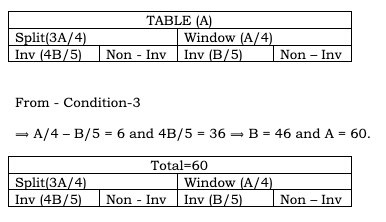 Now, from condition-6
a) D1 & D4 sold "0" window Non-inverter ACs ⟹ D2 & D3 sold 6 window non-inverter ACs, it is given that D2 sold twice as many as D3 ⟹ D2 sold 4 and D3 sold 2 ACs of this type.
From condition-2
b) Let us assume, D1 sold "x" window inverter ACs ⟹ Number of split inverter ACs sold is 13-x From condition-4
c) Number of split ACs sold by D1 will be "2x"
From condition-5
d) Let us assume 'y' is the number of window ACs sold by D3 & D4 ⟹ D2 sold 3y ACs of this type. From condition-7
e) Let us assume 'z' is the number of split inverter ACs sold by D3 and D4 ⟹ D2 sold 2z ACs of this type. Let us use a, b, c, d, and e make a table:
Now, from condition-6
a) D1 & D4 sold "0" window Non-inverter ACs ⟹ D2 & D3 sold 6 window non-inverter ACs, it is given that D2 sold twice as many as D3 ⟹ D2 sold 4 and D3 sold 2 ACs of this type.
From condition-2
b) Let us assume, D1 sold "x" window inverter ACs ⟹ Number of split inverter ACs sold is 13-x From condition-4
c) Number of split ACs sold by D1 will be "2x"
From condition-5
d) Let us assume 'y' is the number of window ACs sold by D3 & D4 ⟹ D2 sold 3y ACs of this type. From condition-7
e) Let us assume 'z' is the number of split inverter ACs sold by D3 and D4 ⟹ D2 sold 2z ACs of this type. Let us use a, b, c, d, and e make a table:
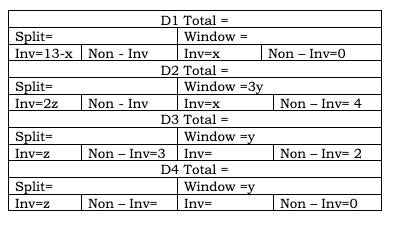 We know that the total number of window ACs is 15
⟹ x + 3y + y + y = 15 ⟹ x + 5y = 15, also x and y should be greater than or equal to 2 from condition – 1
⟹ x = 5 and y = 2 is the only solution.
Filling this in the table:
We know that the total number of window ACs is 15
⟹ x + 3y + y + y = 15 ⟹ x + 5y = 15, also x and y should be greater than or equal to 2 from condition – 1
⟹ x = 5 and y = 2 is the only solution.
Filling this in the table:
 Now, Number of split inverter ACs is 36
⟹ 8 + 2z + z + z = 36 ⟹ 4z = 28 ⟹ z = 7.
Filling this and using (5), the number of split AC's sold by D1 is 2*5 = 10.
Now, Number of split inverter ACs is 36
⟹ 8 + 2z + z + z = 36 ⟹ 4z = 28 ⟹ z = 7.
Filling this and using (5), the number of split AC's sold by D1 is 2*5 = 10.
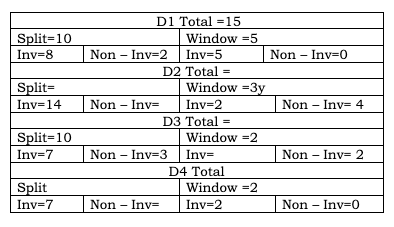 From the table, we see that 14 split inverter ACs are sold.
From the table, we see that 14 split inverter ACs are sold.
2. What percentage of ACs sold were of Non-Inverter type? (in numerical value)
Let us assume, A is the total number of AC's sold
⟹ From the information that the total number of ACs sold in the city, 25% were of Window variant
⟹ Window AC's = A/4 and Split AC's = 3A/4
Now, let us assume B is the total number of inverter ACs
⟹ From the information that among the Inverter ACs sold, 20% were of Window variant.
⟹ Window Inverter AC's = B/5 and Window Non-Inverter AC's = 4B/5
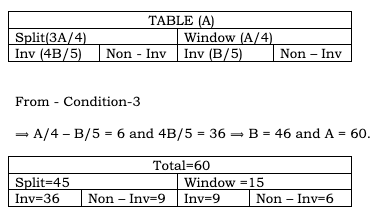 Now, from condition-6
a) D1 & D4 sold "0" window Non-inverter ACs ⟹ D2 & D3 sold 6 window non-inverter ACs, it is given that D2 sold twice as many as D3 ⟹ D2 sold 4 and D3 sold 2 ACs of this type.
From condition-2
b) Let us assume, D1 sold "x" window inverter ACs ⟹ Number of split inverter ACs sold is 13-x From condition-4
c) Number of split ACs sold by D1 will be "2x"
From condition-5
d) Let us assume 'y' is the number of window ACs sold by D3 & D4 ⟹ D2 sold 3y ACs of this type. From condition-7
e) Let us assume 'z' is the number of split inverter ACs sold by D3 and D4 ⟹ D2 sold 2z ACs of this type. Let us use a, b, c, d, and e make a table:
Now, from condition-6
a) D1 & D4 sold "0" window Non-inverter ACs ⟹ D2 & D3 sold 6 window non-inverter ACs, it is given that D2 sold twice as many as D3 ⟹ D2 sold 4 and D3 sold 2 ACs of this type.
From condition-2
b) Let us assume, D1 sold "x" window inverter ACs ⟹ Number of split inverter ACs sold is 13-x From condition-4
c) Number of split ACs sold by D1 will be "2x"
From condition-5
d) Let us assume 'y' is the number of window ACs sold by D3 & D4 ⟹ D2 sold 3y ACs of this type. From condition-7
e) Let us assume 'z' is the number of split inverter ACs sold by D3 and D4 ⟹ D2 sold 2z ACs of this type. Let us use a, b, c, d, and e make a table:
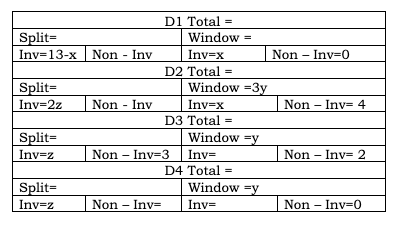 We know that the total number of window ACs is 15
⟹ x + 3y + y + y = 15 ⟹ x + 5y = 15, also x and y should be greater than or equal to 2 from condition – 1
⟹ x = 5 and y = 2 is the only solution.
Filling this in the table:
We know that the total number of window ACs is 15
⟹ x + 3y + y + y = 15 ⟹ x + 5y = 15, also x and y should be greater than or equal to 2 from condition – 1
⟹ x = 5 and y = 2 is the only solution.
Filling this in the table:
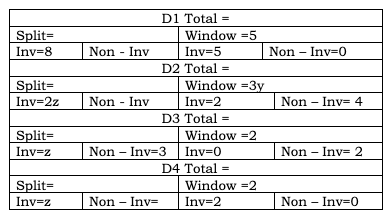 Now, Number of split inverter ACs is 36
⟹ 8 + 2z + z + z = 36 ⟹ 4z = 28 ⟹ z = 7.
Filling this and using (5), the number of split AC's sold by D1 is 2*5 = 10.
Now, Number of split inverter ACs is 36
⟹ 8 + 2z + z + z = 36 ⟹ 4z = 28 ⟹ z = 7.
Filling this and using (5), the number of split AC's sold by D1 is 2*5 = 10.
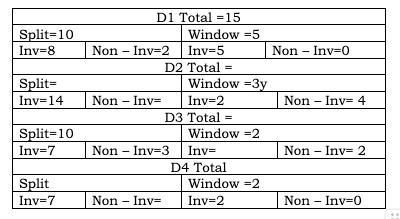 From this table, we see that total number of non-inverter ACs is 9 + 6 = 15.
Required percentage is 15 out of 60 ⟹ 25%.
From this table, we see that total number of non-inverter ACs is 9 + 6 = 15.
Required percentage is 15 out of 60 ⟹ 25%.
3. What was the total number of ACs sold by D2 and D4? (in numerical value)
Let us assume, A is the total number of AC's sold
⟹ From the information that the total number of ACs sold in the city, 25% were of Window variant
⟹ Window AC's = A/4 and Split AC's = 3A/4
Now, let us assume B is the total number of inverter ACs
⟹ From the information that among the Inverter ACs sold, 20% were of Window variant.
⟹ Window Inverter AC's = B/5 and Window Non-Inverter AC's = 4B/5
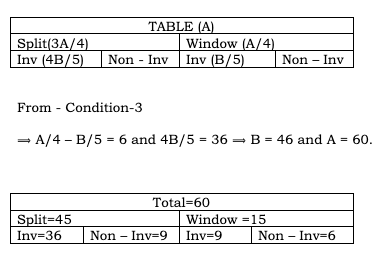 Now, from condition-6
a) D1 & D4 sold "0" window Non-inverter ACs ⟹ D2 & D3 sold 6 window non-inverter ACs, it is given that D2 sold twice as many as D3 ⟹ D2 sold 4 and D3 sold 2 ACs of this type.
From condition-2
b) Let us assume, D1 sold "x" window inverter ACs ⟹ Number of split inverter ACs sold is 13-x From condition-4
c) Number of split ACs sold by D1 will be "2x"
From condition-5
d) Let us assume 'y' is the number of window ACs sold by D3 & D4 ⟹ D2 sold 3y ACs of this type. From condition-7
e) Let us assume 'z' is the number of split inverter ACs sold by D3 and D4 ⟹ D2 sold 2z ACs of this type. Let us use a, b, c, d, and e make a table:
Now, from condition-6
a) D1 & D4 sold "0" window Non-inverter ACs ⟹ D2 & D3 sold 6 window non-inverter ACs, it is given that D2 sold twice as many as D3 ⟹ D2 sold 4 and D3 sold 2 ACs of this type.
From condition-2
b) Let us assume, D1 sold "x" window inverter ACs ⟹ Number of split inverter ACs sold is 13-x From condition-4
c) Number of split ACs sold by D1 will be "2x"
From condition-5
d) Let us assume 'y' is the number of window ACs sold by D3 & D4 ⟹ D2 sold 3y ACs of this type. From condition-7
e) Let us assume 'z' is the number of split inverter ACs sold by D3 and D4 ⟹ D2 sold 2z ACs of this type. Let us use a, b, c, d, and e make a table:
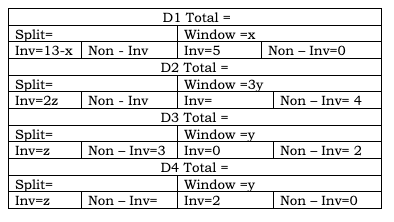 We know that the total number of window ACs is 15
⟹ x + 3y + y + y = 15 ⟹ x + 5y = 15, also x and y should be greater than or equal to 2 from condition – 1
⟹ x = 5 and y = 2 is the only solution.
Filling this in the table:
We know that the total number of window ACs is 15
⟹ x + 3y + y + y = 15 ⟹ x + 5y = 15, also x and y should be greater than or equal to 2 from condition – 1
⟹ x = 5 and y = 2 is the only solution.
Filling this in the table:
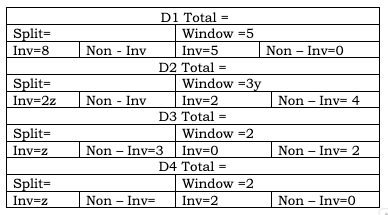 Now, Number of split inverter ACs is 36
⟹ 8 + 2z + z + z = 36 ⟹ 4z = 28 ⟹ z = 7.
Filling this and using (5), the number of split AC's sold by D1 is 2*5 = 10.
Now, Number of split inverter ACs is 36
⟹ 8 + 2z + z + z = 36 ⟹ 4z = 28 ⟹ z = 7.
Filling this and using (5), the number of split AC's sold by D1 is 2*5 = 10.
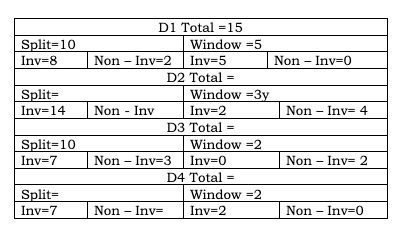 Total number of ACs sold by D2 and D4 = 60 - D1 - D3 = 60 - 15 - 12 = 33.
Total number of ACs sold by D2 and D4 = 60 - D1 - D3 = 60 - 15 - 12 = 33.
4. Which of the following statements is necessarily false?
- D1 and D3 together sold more ACs as compared to D2 and D4 together.
- D4 sold more Split ACs as compared to D3.
- D2 sold the highest number of ACs.
- D1 and D3 sold an equal number of Split ACs.
Let us assume, A is the total number of AC's sold
⟹ From the information that the total number of ACs sold in the city, 25% were of Window variant
⟹ Window AC's = A/4 and Split AC's = 3A/4
Now, let us assume B is the total number of inverter ACs
⟹ From the information that among the Inverter ACs sold, 20% were of Window variant.
⟹ Window Inverter AC's = B/5 and Window Non-Inverter AC's = 4B/5
 Now, from condition-6
a) D1 & D4 sold "0" window Non-inverter ACs ⟹ D2 & D3 sold 6 window non-inverter ACs, it is given that D2 sold twice as many as D3 ⟹ D2 sold 4 and D3 sold 2 ACs of this type.
From condition-2
b) Let us assume, D1 sold "x" window inverter ACs ⟹ Number of split inverter ACs sold is 13-x From condition-4
c) Number of split ACs sold by D1 will be "2x"
From condition-5
d) Let us assume 'y' is the number of window ACs sold by D3 & D4 ⟹ D2 sold 3y ACs of this type. From condition-7
e) Let us assume 'z' is the number of split inverter ACs sold by D3 and D4 ⟹ D2 sold 2z ACs of this type. Let us use a, b, c, d, and e make a table:
Now, from condition-6
a) D1 & D4 sold "0" window Non-inverter ACs ⟹ D2 & D3 sold 6 window non-inverter ACs, it is given that D2 sold twice as many as D3 ⟹ D2 sold 4 and D3 sold 2 ACs of this type.
From condition-2
b) Let us assume, D1 sold "x" window inverter ACs ⟹ Number of split inverter ACs sold is 13-x From condition-4
c) Number of split ACs sold by D1 will be "2x"
From condition-5
d) Let us assume 'y' is the number of window ACs sold by D3 & D4 ⟹ D2 sold 3y ACs of this type. From condition-7
e) Let us assume 'z' is the number of split inverter ACs sold by D3 and D4 ⟹ D2 sold 2z ACs of this type. Let us use a, b, c, d, and e make a table:
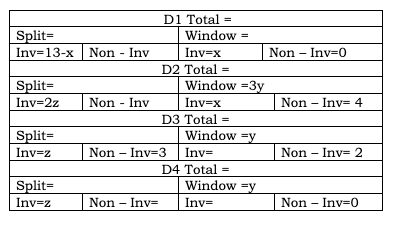 We know that the total number of window ACs is 15
⟹ x + 3y + y + y = 15 ⟹ x + 5y = 15, also x and y should be greater than or equal to 2 from condition – 1
⟹ x = 5 and y = 2 is the only solution.
Filling this in the table:
We know that the total number of window ACs is 15
⟹ x + 3y + y + y = 15 ⟹ x + 5y = 15, also x and y should be greater than or equal to 2 from condition – 1
⟹ x = 5 and y = 2 is the only solution.
Filling this in the table:
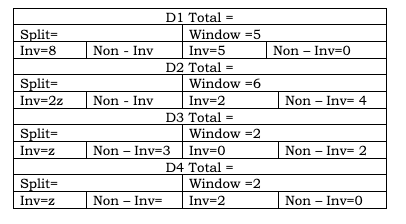 Now, Number of split inverter ACs is 36
⟹ 8 + 2z + z + z = 36 ⟹ 4z = 28 ⟹ z = 7.
Filling this and using (5), the number of split AC's sold by D1 is 2*5 = 10.
Now, Number of split inverter ACs is 36
⟹ 8 + 2z + z + z = 36 ⟹ 4z = 28 ⟹ z = 7.
Filling this and using (5), the number of split AC's sold by D1 is 2*5 = 10.
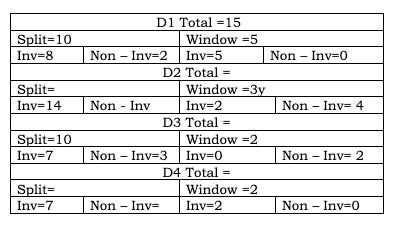 We see that D1 & D3 sold 27 ACs together which is less than 60 – 27 = 33 sold by D2 & D4.
⟹ Option – A is definitely false.
We see that D1 & D3 sold 27 ACs together which is less than 60 – 27 = 33 sold by D2 & D4.
⟹ Option – A is definitely false.
5. If D3 and D4 sold an equal number of ACs, then what was the number of Non-Inverter ACs sold by D2?
- 5
- 7
- 6
- 4
Let us assume, A is the total number of AC's sold
⟹ From the information that the total number of ACs sold in the city, 25% were of Window variant
⟹ Window AC's = A/4 and Split AC's = 3A/4
Now, let us assume B is the total number of inverter ACs
⟹ From the information that among the Inverter ACs sold, 20% were of Window variant.
⟹ Window Inverter AC's = B/5 and Window Non-Inverter AC's = 4B/5
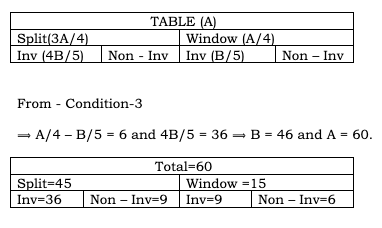 Now, from condition-6
a) D1 & D4 sold "0" window Non-inverter ACs ⟹ D2 & D3 sold 6 window non-inverter ACs, it is given that D2 sold twice as many as D3 ⟹ D2 sold 4 and D3 sold 2 ACs of this type.
From condition-2
b) Let us assume, D1 sold "x" window inverter ACs ⟹ Number of split inverter ACs sold is 13-x From condition-4
c) Number of split ACs sold by D1 will be "2x"
From condition-5
d) Let us assume 'y' is the number of window ACs sold by D3 & D4 ⟹ D2 sold 3y ACs of this type. From condition-7
e) Let us assume 'z' is the number of split inverter ACs sold by D3 and D4 ⟹ D2 sold 2z ACs of this type. Let us use a, b, c, d, and e make a table:
Now, from condition-6
a) D1 & D4 sold "0" window Non-inverter ACs ⟹ D2 & D3 sold 6 window non-inverter ACs, it is given that D2 sold twice as many as D3 ⟹ D2 sold 4 and D3 sold 2 ACs of this type.
From condition-2
b) Let us assume, D1 sold "x" window inverter ACs ⟹ Number of split inverter ACs sold is 13-x From condition-4
c) Number of split ACs sold by D1 will be "2x"
From condition-5
d) Let us assume 'y' is the number of window ACs sold by D3 & D4 ⟹ D2 sold 3y ACs of this type. From condition-7
e) Let us assume 'z' is the number of split inverter ACs sold by D3 and D4 ⟹ D2 sold 2z ACs of this type. Let us use a, b, c, d, and e make a table:
 We know that the total number of window ACs is 15
⟹ x + 3y + y + y = 15 ⟹ x + 5y = 15, also x and y should be greater than or equal to 2 from condition – 1
⟹ x = 5 and y = 2 is the only solution.
Filling this in the table:
We know that the total number of window ACs is 15
⟹ x + 3y + y + y = 15 ⟹ x + 5y = 15, also x and y should be greater than or equal to 2 from condition – 1
⟹ x = 5 and y = 2 is the only solution.
Filling this in the table:
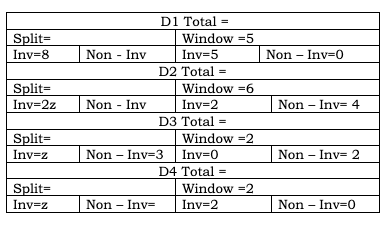 Now, Number of split inverter ACs is 36
⟹ 8 + 2z + z + z = 36 ⟹ 4z = 28 ⟹ z = 7.
Filling this and using (5), the number of split AC's sold by D1 is 2*5 = 10.
Now, Number of split inverter ACs is 36
⟹ 8 + 2z + z + z = 36 ⟹ 4z = 28 ⟹ z = 7.
Filling this and using (5), the number of split AC's sold by D1 is 2*5 = 10.
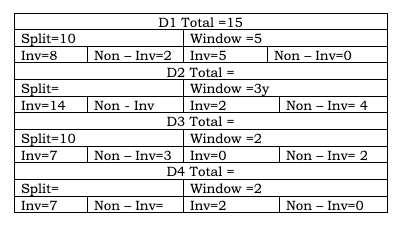 Number of non-inverter ACs sold is 1 + 4 = 5
Number of non-inverter ACs sold is 1 + 4 = 5
Correct Answer 1
14
Correct Answer 2
25
Correct Answer 3
33
Correct Answer 4
Option A
Correct Answer 5
Option A
CAT 2023 | DILR Set 2
DIRECTIONS for the question: Read the information given below and answer the question that follows
The projects are done in groups of two, with each group consisting of a female and a male student. Both the group members obtain the same score in the project.
The following additional facts are known about the scores in the project and the test.
- The minimum, maximum and the average of both project and test scores were identical —40, 80 and 60, respectively.
- The test scores of the students were all multiples of 10; four of them were distinct and the remaining two were equal to the average test scores.
- Amala’s score in the project was double that of Koli in the same, but Koli scored 20 more than Amala in the test. Yet Amala had the highest aggregate score.
- Shyamal scored the second highest in the test. He scored two more than Koli, but two less than Amala in the aggregate.
- Biman scored the second lowest in the test and the lowest in the aggregate.
- Mathew scored more than Rini in the project, but less than her in the test.
6. What was Rini’s score in the project? (in numerical value)
It is given that there are only three female students - Amala, Koli, and Rini - and only three male students - Biman, Mathew, and Shyamal - in a course.
It is also known that the aggregate score in the course is a weighted average of the two components, with the weights being positive and adding to 1.
Let the project score component be x, which implies the test score component will be (1-x). The projects are done in groups of two, with each group consisting of a female and a male student, which implies there are three groups for the project. It is also known that both the group members obtain the same score in the project. The score obtained in the project is 40, 60, and 80, respectively.
Therefore, we can say that each female student will consist of a different group, and no two male students or female students will be in the same group.
For the test scores, there are six scores given for six students among which four are distinct and the remaining two are average scores, which is 60. It is also known that the maximum score possible is 80, and the minimum score is 40.
Hence, the distinct scores are 80, 70, 50, and 40 (since all the test scores are multiple of 10), and the remaining two scores are 60, and 60, respectively.
From point 3, we know that Amala’s score in the project was double that of Koli in the same, but Koli scored 20 more than Amala in the test. Hence, we can say the score obtained by Amala in the project is 80, and the score obtained by Koli is 40, which implies the score obtained by Rini in the project is 60. Now, Koli scored 20 more than Amala in the test, which implies the score obtained by Koli can be either 80, 70, or 60.
The score obtained by them is given below:
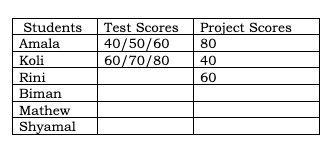 It is known that Amala had the highest aggregate score, and Shyamal scored the second highest on the test. He scored two more than Koli, but two less than Amala in the aggregate.
Hence, the score obtained by Shyamal in the test is 70, which implies Koli can't score 70 in the test ⟹ Amala can't score 50 in the test.
It is known that Amala had the highest aggregate score, and Shyamal scored the second highest on the test. He scored two more than Koli, but two less than Amala in the aggregate.
Hence, the score obtained by Shyamal in the test is 70, which implies Koli can't score 70 in the test ⟹ Amala can't score 50 in the test.
 It is given that Shyamal scored two more than Koli, but two less than Amala in the aggregate. Hence, the aggregate score of Amala is 4 more than Koli. It is also known that Amala had the highest aggregate score.
Case 1: The test score of Amala is 40
It is given that Shyamal scored two more than Koli, but two less than Amala in the aggregate. Hence, the aggregate score of Amala is 4 more than Koli. It is also known that Amala had the highest aggregate score.
Case 1: The test score of Amala is 40
 Therefore, 40(1 - x) + 80x = 60(1 - x) + 40x + 4
⟹ 60x = 24
⟹ x = 0.4
Hence, the aggregate score obtained by Amala is 40(1 – 0.4) + 80 * 4 = 56
The minimum aggregate score of Shyamal is 70(1 – 0.4) + 40 * 0.4 = 58, which is greater than Amala.
Hence, Case 1 is not possible.
Hence, the table is given below:
Therefore, 40(1 - x) + 80x = 60(1 - x) + 40x + 4
⟹ 60x = 24
⟹ x = 0.4
Hence, the aggregate score obtained by Amala is 40(1 – 0.4) + 80 * 4 = 56
The minimum aggregate score of Shyamal is 70(1 – 0.4) + 40 * 0.4 = 58, which is greater than Amala.
Hence, Case 1 is not possible.
Hence, the table is given below:
 Therefore, 60(1 - x) + 80x = 80(1 - x) + 40x + 4
⟹ 60 + 20x = 84 – 40x
⟹ 60x = 24 ⟹ x = 0.4
Hence, the aggregate score of Amala is 60 (1 – 0.4) + 80 * 0.4 = 68, which implies the aggregate score of Shyamal is (68 – 2) = 66
Hence, the score obtained by Shyamal in Project is {66 – 70*(0.6)}/0.4 = 60.
It is also known that Biman scored second lowest in the test, which implies the score of Biman in the test is 50, and he scored the lowest in the aggregate. It is also known that Mathew scored more than Rini in the project, but less than her in the test. Hence, Mathew scored 80 in the project (since Rini scored 60 in the project), and Biman scored 40 in the project.
Similarly, Rini Scored more than Mathew on the test, which implies the score obtained by Rini is 60, and the score obtained by Mathew is 40 in the test.
Hence, the final table will look like this:
Therefore, 60(1 - x) + 80x = 80(1 - x) + 40x + 4
⟹ 60 + 20x = 84 – 40x
⟹ 60x = 24 ⟹ x = 0.4
Hence, the aggregate score of Amala is 60 (1 – 0.4) + 80 * 0.4 = 68, which implies the aggregate score of Shyamal is (68 – 2) = 66
Hence, the score obtained by Shyamal in Project is {66 – 70*(0.6)}/0.4 = 60.
It is also known that Biman scored second lowest in the test, which implies the score of Biman in the test is 50, and he scored the lowest in the aggregate. It is also known that Mathew scored more than Rini in the project, but less than her in the test. Hence, Mathew scored 80 in the project (since Rini scored 60 in the project), and Biman scored 40 in the project.
Similarly, Rini Scored more than Mathew on the test, which implies the score obtained by Rini is 60, and the score obtained by Mathew is 40 in the test.
Hence, the final table will look like this:
 Hence, the score obtained by Rini in the project is 60
Hence, the score obtained by Rini in the project is 60
7. What was the weight of the test component?
- 0.50
- 0.60
- 0.40
- 0.75
It is given that there are only three female students - Amala, Koli, and Rini - and only three male students - Biman, Mathew, and Shyamal - in a course.
It is also known that the aggregate score in the course is a weighted average of the two components, with the weights being positive and adding to 1.
Let the project score component be x, which implies the test score component will be (1-x). The projects are done in groups of two, with each group consisting of a female and a male student, which implies there are three groups for the project. It is also known that both the group members obtain the same score in the project. The score obtained in the project is 40, 60, and 80, respectively.
Therefore, we can say that each female student will consist of a different group, and no two male students or female students will be in the same group.
For the test scores, there are six scores given for six students among which four are distinct and the remaining two are average scores, which is 60. It is also known that the maximum score possible is 80, and the minimum score is 40.
Hence, the distinct scores are 80, 70, 50, and 40 (since all the test scores are multiple of 10), and the remaining two scores are 60, and 60, respectively.
From point 3, we know that Amala’s score in the project was double that of Koli in the same, but Koli scored 20 more than Amala in the test. Hence, we can say the score obtained by Amala in the project is 80, and the score obtained by Koli is 40, which implies the score obtained by Rini in the project is 60. Now, Koli scored 20 more than Amala in the test, which implies the score obtained by Koli can be either 80, 70, or 60.
The score obtained by them is given below:
 It is known that Amala had the highest aggregate score, and Shyamal scored the second highest on the test. He scored two more than Koli, but two less than Amala in the aggregate.
Hence, the score obtained by Shyamal in the test is 70, which implies Koli can't score 70 in the test ⟹ Amala can't score 50 in the test.
It is known that Amala had the highest aggregate score, and Shyamal scored the second highest on the test. He scored two more than Koli, but two less than Amala in the aggregate.
Hence, the score obtained by Shyamal in the test is 70, which implies Koli can't score 70 in the test ⟹ Amala can't score 50 in the test.
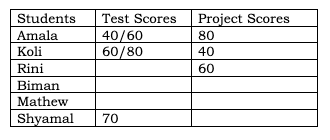 It is given that Shyamal scored two more than Koli, but two less than Amala in the aggregate. Hence, the aggregate score of Amala is 4 more than Koli. It is also known that Amala had the highest aggregate score.
Case 1: The test score of Amala is 40
It is given that Shyamal scored two more than Koli, but two less than Amala in the aggregate. Hence, the aggregate score of Amala is 4 more than Koli. It is also known that Amala had the highest aggregate score.
Case 1: The test score of Amala is 40
 Therefore, 40(1 - x) + 80x = 60(1 - x) + 40x + 4
⟹ 60x = 24
⟹ x = 0.4
Hence, the aggregate score obtained by Amala is 40(1 – 0.4) + 80 * 4 = 56
The minimum aggregate score of Shyamal is 70(1 – 0.4) + 40 * 0.4 = 58, which is greater than Amala.
Hence, Case 1 is not possible.
Hence, the table is given below:
Therefore, 40(1 - x) + 80x = 60(1 - x) + 40x + 4
⟹ 60x = 24
⟹ x = 0.4
Hence, the aggregate score obtained by Amala is 40(1 – 0.4) + 80 * 4 = 56
The minimum aggregate score of Shyamal is 70(1 – 0.4) + 40 * 0.4 = 58, which is greater than Amala.
Hence, Case 1 is not possible.
Hence, the table is given below:
 Therefore, 60(1 - x) + 80x = 80(1 - x) + 40x + 4
⟹ 60 + 20x = 84 – 40x
⟹ 60x = 24 ⟹ x = 0.4
Hence, the aggregate score of Amala is 60 (1 – 0.4) + 80 * 0.4 = 68, which implies the aggregate score of Shyamal is (68 – 2) = 66
Hence, the score obtained by Shyamal in Project is {66 – 70*(0.6)}/0.4 = 60.
It is also known that Biman scored second lowest in the test, which implies the score of Biman in the test is 50, and he scored the lowest in the aggregate. It is also known that Mathew scored more than Rini in the project, but less than her in the test. Hence, Mathew scored 80 in the project (since Rini scored 60 in the project), and Biman scored 40 in the project.
Similarly, Rini Scored more than Mathew on the test, which implies the score obtained by Rini is 60, and the score obtained by Mathew is 40 in the test.
Hence, the final table will look like this:
Therefore, 60(1 - x) + 80x = 80(1 - x) + 40x + 4
⟹ 60 + 20x = 84 – 40x
⟹ 60x = 24 ⟹ x = 0.4
Hence, the aggregate score of Amala is 60 (1 – 0.4) + 80 * 0.4 = 68, which implies the aggregate score of Shyamal is (68 – 2) = 66
Hence, the score obtained by Shyamal in Project is {66 – 70*(0.6)}/0.4 = 60.
It is also known that Biman scored second lowest in the test, which implies the score of Biman in the test is 50, and he scored the lowest in the aggregate. It is also known that Mathew scored more than Rini in the project, but less than her in the test. Hence, Mathew scored 80 in the project (since Rini scored 60 in the project), and Biman scored 40 in the project.
Similarly, Rini Scored more than Mathew on the test, which implies the score obtained by Rini is 60, and the score obtained by Mathew is 40 in the test.
Hence, the final table will look like this:
 Hence, the weight of the test component is 0.60
The correct option is B
Hence, the weight of the test component is 0.60
The correct option is B
8. What was the maximum aggregate score obtained by the students?
- 68
- 80
- 66
- 62
It is given that there are only three female students - Amala, Koli, and Rini - and only three male students - Biman, Mathew, and Shyamal - in a course.
It is also known that the aggregate score in the course is a weighted average of the two components, with the weights being positive and adding to 1.
Let the project score component be x, which implies the test score component will be (1-x). The projects are done in groups of two, with each group consisting of a female and a male student, which implies there are three groups for the project. It is also known that both the group members obtain the same score in the project. The score obtained in the project is 40, 60, and 80, respectively.
Therefore, we can say that each female student will consist of a different group, and no two male students or female students will be in the same group.
For the test scores, there are six scores given for six students among which four are distinct and the remaining two are average scores, which is 60. It is also known that the maximum score possible is 80, and the minimum score is 40.
Hence, the distinct scores are 80, 70, 50, and 40 (since all the test scores are multiple of 10), and the remaining two scores are 60, and 60, respectively.
From point 3, we know that Amala’s score in the project was double that of Koli in the same, but Koli scored 20 more than Amala in the test. Hence, we can say the score obtained by Amala in the project is 80, and the score obtained by Koli is 40, which implies the score obtained by Rini in the project is 60. Now, Koli scored 20 more than Amala in the test, which implies the score obtained by Koli can be either 80, 70, or 60.
The score obtained by them is given below:
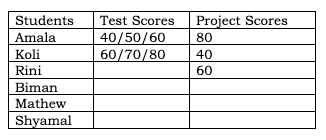 It is known that Amala had the highest aggregate score, and Shyamal scored the second highest on the test. He scored two more than Koli, but two less than Amala in the aggregate.
Hence, the score obtained by Shyamal in the test is 70, which implies Koli can't score 70 in the test ⟹ Amala can't score 50 in the test.
It is known that Amala had the highest aggregate score, and Shyamal scored the second highest on the test. He scored two more than Koli, but two less than Amala in the aggregate.
Hence, the score obtained by Shyamal in the test is 70, which implies Koli can't score 70 in the test ⟹ Amala can't score 50 in the test.
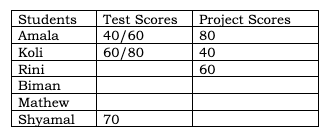 It is given that Shyamal scored two more than Koli, but two less than Amala in the aggregate. Hence, the aggregate score of Amala is 4 more than Koli. It is also known that Amala had the highest aggregate score.
Case 1: The test score of Amala is 40
It is given that Shyamal scored two more than Koli, but two less than Amala in the aggregate. Hence, the aggregate score of Amala is 4 more than Koli. It is also known that Amala had the highest aggregate score.
Case 1: The test score of Amala is 40
 Therefore, 40(1 - x) + 80x = 60(1 - x) + 40x + 4
⟹ 60x = 24
⟹ x = 0.4
Hence, the aggregate score obtained by Amala is 40(1 – 0.4) + 80 * 4 = 56
The minimum aggregate score of Shyamal is 70(1 – 0.4) + 40 * 0.4 = 58, which is greater than Amala.
Hence, Case 1 is not possible.
Hence, the table is given below:
Therefore, 40(1 - x) + 80x = 60(1 - x) + 40x + 4
⟹ 60x = 24
⟹ x = 0.4
Hence, the aggregate score obtained by Amala is 40(1 – 0.4) + 80 * 4 = 56
The minimum aggregate score of Shyamal is 70(1 – 0.4) + 40 * 0.4 = 58, which is greater than Amala.
Hence, Case 1 is not possible.
Hence, the table is given below:
 Therefore, 60(1 – x) + 80x = 80(1 – x) + 40x + 4
⟹ 60 + 20x = 84 – 40x
⟹ 60x = 24 ⟹ x = 0.4
Hence, the aggregate score of Amala is 60 (1 – 0.4) + 80 * 0.4 = 68, which implies the aggregate score of Shyamal is (68 – 2) = 66
Hence, the score obtained by Shyamal in Project is {66 – 70*(0.6)}/0.4 = 60.
It is also known that Biman scored second lowest in the test, which implies the score of Biman in the test is 50, and he scored the lowest in the aggregate. It is also known that Mathew scored more than Rini in the project, but less than her in the test. Hence, Mathew scored 80 in the project (since Rini scored 60 in the project), and Biman scored 40 in the project.
Similarly, Rini Scored more than Mathew on the test, which implies the score obtained by Rini is 60, and the score obtained by Mathew is 40 in the test.
Hence, the final table will look like this:
Therefore, 60(1 – x) + 80x = 80(1 – x) + 40x + 4
⟹ 60 + 20x = 84 – 40x
⟹ 60x = 24 ⟹ x = 0.4
Hence, the aggregate score of Amala is 60 (1 – 0.4) + 80 * 0.4 = 68, which implies the aggregate score of Shyamal is (68 – 2) = 66
Hence, the score obtained by Shyamal in Project is {66 – 70*(0.6)}/0.4 = 60.
It is also known that Biman scored second lowest in the test, which implies the score of Biman in the test is 50, and he scored the lowest in the aggregate. It is also known that Mathew scored more than Rini in the project, but less than her in the test. Hence, Mathew scored 80 in the project (since Rini scored 60 in the project), and Biman scored 40 in the project.
Similarly, Rini Scored more than Mathew on the test, which implies the score obtained by Rini is 60, and the score obtained by Mathew is 40 in the test.
Hence, the final table will look like this:

9. What was Mathew’s score in the test? (in numerical value)
It is given that there are only three female students - Amala, Koli, and Rini - and only three male students - Biman, Mathew, and Shyamal - in a course.
It is also known that the aggregate score in the course is a weighted average of the two components, with the weights being positive and adding to 1.
Let the project score component be x, which implies the test score component will be (1-x). The projects are done in groups of two, with each group consisting of a female and a male student, which implies there are three groups for the project. It is also known that both the group members obtain the same score in the project. The score obtained in the project is 40, 60, and 80, respectively.
Therefore, we can say that each female student will consist of a different group, and no two male students or female students will be in the same group.
For the test scores, there are six scores given for six students among which four are distinct and the remaining two are average scores, which is 60. It is also known that the maximum score possible is 80, and the minimum score is 40.
Hence, the distinct scores are 80, 70, 50, and 40 (since all the test scores are multiple of 10), and the remaining two scores are 60, and 60, respectively.
From point 3, we know that Amala’s score in the project was double that of Koli in the same, but Koli scored 20 more than Amala in the test. Hence, we can say the score obtained by Amala in the project is 80, and the score obtained by Koli is 40, which implies the score obtained by Rini in the project is 60. Now, Koli scored 20 more than Amala in the test, which implies the score obtained by Koli can be either 80, 70, or 60.
The score obtained by them is given below:
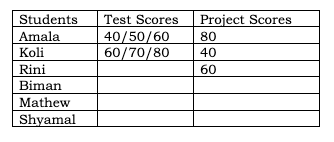 It is known that Amala had the highest aggregate score, and Shyamal scored the second highest on the test. He scored two more than Koli, but two less than Amala in the aggregate.
Hence, the score obtained by Shyamal in the test is 70, which implies Koli can't score 70 in the test ⟹ Amala can't score 50 in the test.
It is known that Amala had the highest aggregate score, and Shyamal scored the second highest on the test. He scored two more than Koli, but two less than Amala in the aggregate.
Hence, the score obtained by Shyamal in the test is 70, which implies Koli can't score 70 in the test ⟹ Amala can't score 50 in the test.
 It is given that Shyamal scored two more than Koli, but two less than Amala in the aggregate. Hence, the aggregate score of Amala is 4 more than Koli. It is also known that Amala had the highest aggregate score.
Case 1: The test score of Amala is 40
It is given that Shyamal scored two more than Koli, but two less than Amala in the aggregate. Hence, the aggregate score of Amala is 4 more than Koli. It is also known that Amala had the highest aggregate score.
Case 1: The test score of Amala is 40
 Therefore, 40(1 - x) + 80x = 60(1 - x) + 40x + 4
⟹ 60x = 24
⟹ x = 0.4
Hence, the aggregate score obtained by Amala is 40(1 – 0.4) + 80 * 4 = 56
The minimum aggregate score of Shyamal is 70(1 – 0.4) + 40 * 0.4 = 58, which is greater than Amala.
Hence, Case 1 is not possible.
Hence, the table is given below:
Therefore, 40(1 - x) + 80x = 60(1 - x) + 40x + 4
⟹ 60x = 24
⟹ x = 0.4
Hence, the aggregate score obtained by Amala is 40(1 – 0.4) + 80 * 4 = 56
The minimum aggregate score of Shyamal is 70(1 – 0.4) + 40 * 0.4 = 58, which is greater than Amala.
Hence, Case 1 is not possible.
Hence, the table is given below:
 Therefore, 60(1 – x) + 80x = 80(1 – x) + 40x + 4
⟹ 60 + 20x = 84 – 40x
⟹ 60x = 24 ⟹ x = 0.4
Hence, the aggregate score of Amala is 60 (1 – 0.4) + 80 * 0.4 = 68, which implies the aggregate score of Shyamal is (68 – 2) = 66
Hence, the score obtained by Shyamal in Project is {66 – 70*(0.6)}/0.4 = 60.
It is also known that Biman scored second lowest in the test, which implies the score of Biman in the test is 50, and he scored the lowest in the aggregate. It is also known that Mathew scored more than Rini in the project, but less than her in the test. Hence, Mathew scored 80 in the project (since Rini scored 60 in the project), and Biman scored 40 in the project.
Similarly, Rini Scored more than Mathew on the test, which implies the score obtained by Rini is 60, and the score obtained by Mathew is 40 in the test.
Hence, the final table will look like this:
Therefore, 60(1 – x) + 80x = 80(1 – x) + 40x + 4
⟹ 60 + 20x = 84 – 40x
⟹ 60x = 24 ⟹ x = 0.4
Hence, the aggregate score of Amala is 60 (1 – 0.4) + 80 * 0.4 = 68, which implies the aggregate score of Shyamal is (68 – 2) = 66
Hence, the score obtained by Shyamal in Project is {66 – 70*(0.6)}/0.4 = 60.
It is also known that Biman scored second lowest in the test, which implies the score of Biman in the test is 50, and he scored the lowest in the aggregate. It is also known that Mathew scored more than Rini in the project, but less than her in the test. Hence, Mathew scored 80 in the project (since Rini scored 60 in the project), and Biman scored 40 in the project.
Similarly, Rini Scored more than Mathew on the test, which implies the score obtained by Rini is 60, and the score obtained by Mathew is 40 in the test.
Hence, the final table will look like this:

10. Which of the following pairs of students were part of the same project team?
i) Amala and Biman
ii) Koli and Mathew
- Both (i) and (ii)
- Only (ii)
- Neither (i) nor (ii)
- Only (i)
It is given that there are only three female students - Amala, Koli, and Rini - and only three male students - Biman, Mathew, and Shyamal - in a course.
It is also known that the aggregate score in the course is a weighted average of the two components, with the weights being positive and adding to 1.
Let the project score component be x, which implies the test score component will be (1-x). The projects are done in groups of two, with each group consisting of a female and a male student, which implies there are three groups for the project. It is also known that both the group members obtain the same score in the project. The score obtained in the project is 40, 60, and 80, respectively.
Therefore, we can say that each female student will consist of a different group, and no two male students or female students will be in the same group.
For the test scores, there are six scores given for six students among which four are distinct and the remaining two are average scores, which is 60. It is also known that the maximum score possible is 80, and the minimum score is 40.
Hence, the distinct scores are 80, 70, 50, and 40 (since all the test scores are multiple of 10), and the remaining two scores are 60, and 60, respectively.
From point 3, we know that Amala’s score in the project was double that of Koli in the same, but Koli scored 20 more than Amala in the test. Hence, we can say the score obtained by Amala in the project is 80, and the score obtained by Koli is 40, which implies the score obtained by Rini in the project is 60. Now, Koli scored 20 more than Amala in the test, which implies the score obtained by Koli can be either 80, 70, or 60.
The score obtained by them is given below:
 It is known that Amala had the highest aggregate score, and Shyamal scored the second highest on the test. He scored two more than Koli, but two less than Amala in the aggregate.
Hence, the score obtained by Shyamal in the test is 70, which implies Koli can't score 70 in the test ⟹ Amala can't score 50 in the test.
It is known that Amala had the highest aggregate score, and Shyamal scored the second highest on the test. He scored two more than Koli, but two less than Amala in the aggregate.
Hence, the score obtained by Shyamal in the test is 70, which implies Koli can't score 70 in the test ⟹ Amala can't score 50 in the test.
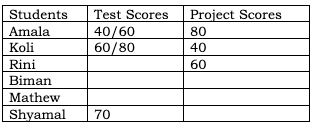 It is given that Shyamal scored two more than Koli, but two less than Amala in the aggregate. Hence, the aggregate score of Amala is 4 more than Koli. It is also known that Amala had the highest aggregate score.
Case 1: The test score of Amala is 40
It is given that Shyamal scored two more than Koli, but two less than Amala in the aggregate. Hence, the aggregate score of Amala is 4 more than Koli. It is also known that Amala had the highest aggregate score.
Case 1: The test score of Amala is 40
 Therefore, 40(1 - x) + 80x = 60(1 - x) + 40x + 4
⟹ 60x = 24
⟹ x = 0.4
Hence, the aggregate score obtained by Amala is 40(1 – 0.4) + 80 * 4 = 56
The minimum aggregate score of Shyamal is 70(1 – 0.4) + 40 * 0.4 = 58, which is greater than Amala.
Hence, Case 1 is not possible.
Hence, the table is given below:
Therefore, 40(1 - x) + 80x = 60(1 - x) + 40x + 4
⟹ 60x = 24
⟹ x = 0.4
Hence, the aggregate score obtained by Amala is 40(1 – 0.4) + 80 * 4 = 56
The minimum aggregate score of Shyamal is 70(1 – 0.4) + 40 * 0.4 = 58, which is greater than Amala.
Hence, Case 1 is not possible.
Hence, the table is given below:
 Therefore, 60(1 – x) + 80x = 80(1 – x) + 40x + 4
⟹ 60 + 20x = 84 – 40x
⟹ 60x = 24 ⟹ x = 0.4
Hence, the aggregate score of Amala is 60 (1 – 0.4) + 80 * 0.4 = 68, which implies the aggregate score of Shyamal is (68 – 2) = 66
Hence, the score obtained by Shyamal in Project is {66 – 70*(0.6)}/0.4 = 60.
It is also known that Biman scored second lowest in the test, which implies the score of Biman in the test is 50, and he scored the lowest in the aggregate. It is also known that Mathew scored more than Rini in the project, but less than her in the test. Hence, Mathew scored 80 in the project (since Rini scored 60 in the project), and Biman scored 40 in the project.
Similarly, Rini Scored more than Mathew on the test, which implies the score obtained by Rini is 60, and the score obtained by Mathew is 40 in the test.
Hence, the final table will look like this:
Therefore, 60(1 – x) + 80x = 80(1 – x) + 40x + 4
⟹ 60 + 20x = 84 – 40x
⟹ 60x = 24 ⟹ x = 0.4
Hence, the aggregate score of Amala is 60 (1 – 0.4) + 80 * 0.4 = 68, which implies the aggregate score of Shyamal is (68 – 2) = 66
Hence, the score obtained by Shyamal in Project is {66 – 70*(0.6)}/0.4 = 60.
It is also known that Biman scored second lowest in the test, which implies the score of Biman in the test is 50, and he scored the lowest in the aggregate. It is also known that Mathew scored more than Rini in the project, but less than her in the test. Hence, Mathew scored 80 in the project (since Rini scored 60 in the project), and Biman scored 40 in the project.
Similarly, Rini Scored more than Mathew on the test, which implies the score obtained by Rini is 60, and the score obtained by Mathew is 40 in the test.
Hence, the final table will look like this:

Correct Answer 6
60
Correct Answer 7
Option B
Correct Answer 8
Option A
Correct Answer 9
40
Correct Answer 10
Option C
CAT 2023 | DILR Set 3
DIRECTIONS for the question: Read the information given below and answer the question that follows.
A, B, C, D, E and F are the six police stations in an area, which are connected by streets as shown below. Four teams – Team 1, Team 2, Team 3 and Team 4 – patrol these streets continuously between 09:00 hrs and 12:00 hrs each day.

The teams need 30 minutes to cross a street connecting one police station to another. All four teams start from Station A at 09:00 hrs and must return to Station A by 12:00 hrs. They can also pass via Station A at any point on their journeys.
The following facts are known.
- None of the streets has more than one team traveling along it in any direction at any point in time.
- Teams 2 and 3 are the only ones in stations E and D respectively at 10:00 hrs.
- Teams 1 and 3 are the only ones in station E at 10:30 hrs.
- Teams 1 and 4 are the only ones in stations B and E respectively at 11:30 hrs.
- Team 1 and Team 4 are the only teams that patrol the street connecting stations A and E.
- Team 4 never passes through Stations B, D or F.
11. Which one among the following stations is visited the largest number of times?
- Station F
- Station C
- Station D
- Station E
It is given that none of the streets has more than one team traveling along it in any direction at any point in time (point 1), which implies at 9.00 hrs, all 4 teams have chosen different roots from the starting point.
It is also known that Teams 2 and 3 are the only ones in stations E and D respectively at 10:00 hrs, and Team 1 and Team 4 are the only teams that patrol the street connecting stations A and E.
It is only possible when Team 2 traveled (A – E) via F, and Team 3 reached station D via station C.
It is also known that Teams 1 and 3 are the only ones in Station E at 10:30 hrs, and Team 4 never passes through Stations B, D, or F. Hence, Team 1 must have chosen the (A – B) root at the starting point, and Team 4 has chosen the (A – E) root at 9.00 hrs.
Hence, Team 1 will reach B at 9.30, and come to A at 10.00 hrs. After that, they will go to E at 10.30 hrs.
Since Team 4 never passes through stations B, D, or F. Team 4 only can pass through stations A, E, and C. Hence, the roots of team 4 to reach station E at 11.30 will be (A – E – A – C – A – E) or (A – E – A – E – A– E).
Since team 1 is already traveling to E from A at 10.00 hrs, at that time team 4 can't choose the same route. Hence, the final route for team 4 to reach E at 11.30 is (A – E – A – C – A – E), and at 12.00 hrs, team 4 will come back to station A.
Hence, the complete route diagram for team 4 is (A – E – A – C – A – E – A)
 The only possible root for Team 2 at 10.00 hrs is from E to F since they can't choose E to D because Team 3 is already on this route. Since team 3 has to reach A at 12.00. The only possible combination for team 3 is E – D – C – A
Now the roots for team 2 going back to A is from F at 10.30 hrs (F – A – F – A) or (F – E – F – A).
Hence, the final table is given below:
The only possible root for Team 2 at 10.00 hrs is from E to F since they can't choose E to D because Team 3 is already on this route. Since team 3 has to reach A at 12.00. The only possible combination for team 3 is E – D – C – A
Now the roots for team 2 going back to A is from F at 10.30 hrs (F – A – F – A) or (F – E – F – A).
Hence, the final table is given below:
 From the table, we can see that among the options station E is visited the largest number of times.
From the table, we can see that among the options station E is visited the largest number of times.
12. How many times do the teams pass through Station B in a day? (in numerical value)
It is given that none of the streets has more than one team traveling along it in any direction at any point in time (point 1), which implies at 9.00 hrs, all 4 teams have chosen different roots from the starting point.
It is also known that Teams 2 and 3 are the only ones in stations E and D respectively at 10:00 hrs, and Team 1 and Team 4 are the only teams that patrol the street connecting stations A and E.
It is only possible when Team 2 traveled (A – E) via F, and Team 3 reached station D via station C.
It is also known that Teams 1 and 3 are the only ones in Station E at 10:30 hrs, and Team 4 never passes through Stations B, D, or F. Hence, Team 1 must have chosen the (A – B) root at the starting point, and Team 4 has chosen the (A – E) root at 9.00 hrs.
Hence, Team 1 will reach B at 9.30, and come to A at 10.00 hrs. After that, they will go to E at 10.30 hrs.
Since Team 4 never passes through stations B, D, or F. Team 4 only can pass through stations A, E, and C. Hence, the roots of team 4 to reach station E at 11.30 will be (A – E – A – C – A – E) or (A – E – A – E – A– E).
Since team 1 is already traveling to E from A at 10.00 hrs, at that time team 4 can't choose the same route. Hence, the final route for team 4 to reach E at 11.30 is (A – E – A – C – A – E), and at 12.00 hrs, team 4 will come back to station A.
Hence, the complete route diagram for team 4 is (A – E – A – C – A – E – A)
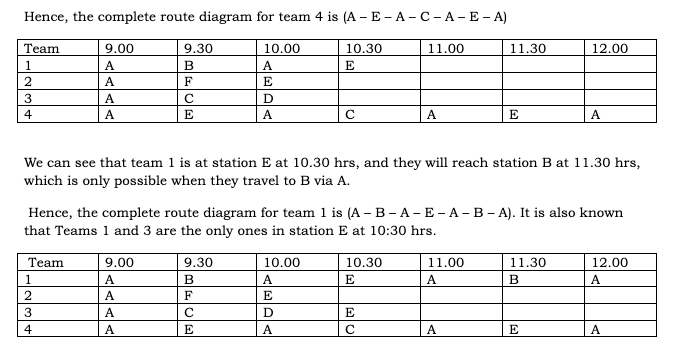 The only possible root for Team 2 at 10.00 hrs is from E to F since they can't choose E to D because Team 3 is already on this route. Since team 3 has to reach A at 12.00. The only possible combination for team 3 is E – D – C – A
The only possible root for Team 2 at 10.00 hrs is from E to F since they can't choose E to D because Team 3 is already on this route. Since team 3 has to reach A at 12.00. The only possible combination for team 3 is E – D – C – A
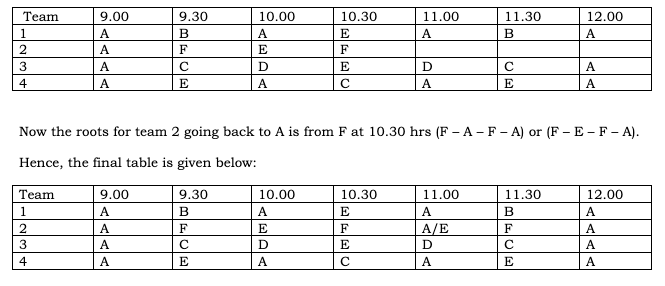 From the table, we can see that the teams have passed through B 2 times in this given period.
From the table, we can see that the teams have passed through B 2 times in this given period.
13. Which team patrols the street connecting Stations D and E at 10:15 hrs?
- Team 3
- Team 4
- Team 2
- Team 1
It is given that none of the streets has more than one team traveling along it in any direction at any point in time (point 1), which implies at 9.00 hrs, all 4 teams have chosen different roots from the starting point.
It is also known that Teams 2 and 3 are the only ones in stations E and D respectively at 10:00 hrs, and Team 1 and Team 4 are the only teams that patrol the street connecting stations A and E.
It is only possible when Team 2 traveled (A – E) via F, and Team 3 reached station D via station C.
It is also known that Teams 1 and 3 are the only ones in Station E at 10:30 hrs, and Team 4 never passes through Stations B, D, or F. Hence, Team 1 must have chosen the (A – B) root at the starting point, and Team 4 has chosen the (A – E) root at 9.00 hrs.
Hence, Team 1 will reach B at 9.30, and come to A at 10.00 hrs. After that, they will go to E at 10.30 hrs.
Since Team 4 never passes through stations B, D, or F. Team 4 only can pass through stations A, E, and C. Hence, the roots of team 4 to reach station E at 11.30 will be (A – E – A – C – A – E) or (A – E – A – E – A– E).
Since team 1 is already traveling to E from A at 10.00 hrs, at that time team 4 can't choose the same route. Hence, the final route for team 4 to reach E at 11.30 is (A – E – A – C – A – E), and at 12.00 hrs, team 4 will come back to station A.
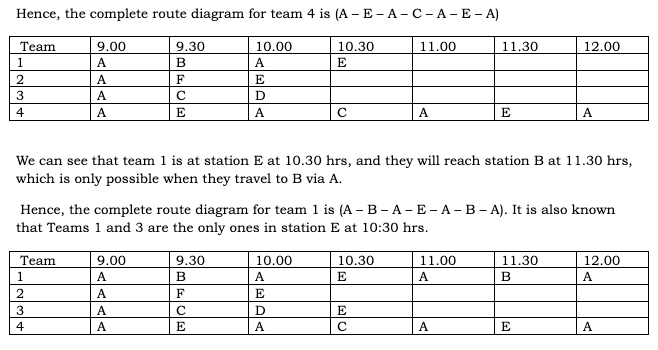 The only possible root for Team 2 at 10.00 hrs is from E to F since they can't choose E to D because Team 3 is already on this route. Since team 3 has to reach A at 12.00. The only possible combination for team 3 is E – D – C – A
The only possible root for Team 2 at 10.00 hrs is from E to F since they can't choose E to D because Team 3 is already on this route. Since team 3 has to reach A at 12.00. The only possible combination for team 3 is E – D – C – A
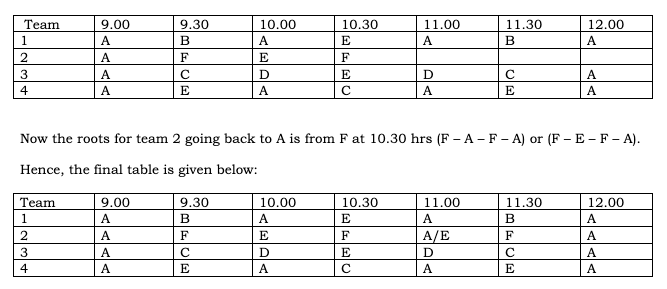 From the table, we can see that at 10.15 hrs, team 3 is travelling from station D to station E.
The correct option is A.
From the table, we can see that at 10.15 hrs, team 3 is travelling from station D to station E.
The correct option is A.
14. How many times does Team 4 pass through Station E in a day? (in numerical value)
It is given that none of the streets has more than one team traveling along it in any direction at any point in time (point 1), which implies at 9.00 hrs, all 4 teams have chosen different roots from the starting point.
It is also known that Teams 2 and 3 are the only ones in stations E and D respectively at 10:00 hrs, and Team 1 and Team 4 are the only teams that patrol the street connecting stations A and E.
It is only possible when Team 2 traveled (A – E) via F, and Team 3 reached station D via station C.
It is also known that Teams 1 and 3 are the only ones in Station E at 10:30 hrs, and Team 4 never passes through Stations B, D, or F. Hence, Team 1 must have chosen the (A – B) root at the starting point, and Team 4 has chosen the (A – E) root at 9.00 hrs.
Hence, Team 1 will reach B at 9.30, and come to A at 10.00 hrs. After that, they will go to E at 10.30 hrs.
Since Team 4 never passes through stations B, D, or F. Team 4 only can pass through stations A, E, and C. Hence, the roots of team 4 to reach station E at 11.30 will be (A – E – A – C – A – E) or (A – E – A – E – A– E).
Since team 1 is already traveling to E from A at 10.00 hrs, at that time team 4 can't choose the same route. Hence, the final route for team 4 to reach E at 11.30 is (A – E – A – C – A – E), and at 12.00 hrs, team 4 will come back to station A.
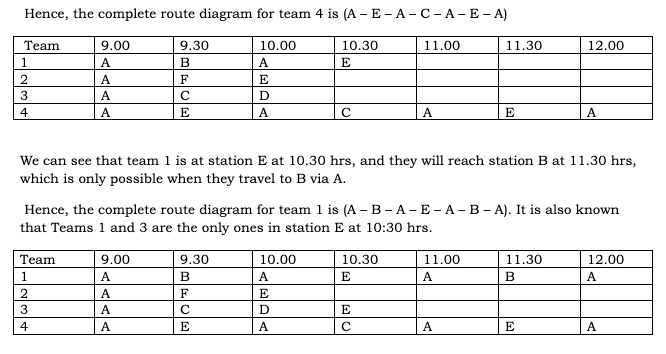 The only possible root for Team 2 at 10.00 hrs is from E to F since they can't choose E to D because Team 3 is already on this route. Since team 3 has to reach A at 12.00. The only possible combination for team 3 is E – D – C – A
The only possible root for Team 2 at 10.00 hrs is from E to F since they can't choose E to D because Team 3 is already on this route. Since team 3 has to reach A at 12.00. The only possible combination for team 3 is E – D – C – A
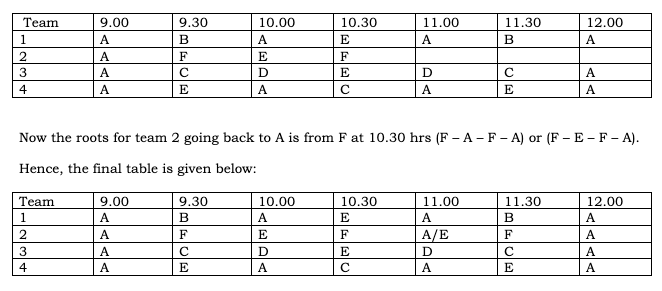 From the table, we can see that team 4 passed station E 2 times in a day
From the table, we can see that team 4 passed station E 2 times in a day
15. How many teams pass through Station C in a day?
- 4
- 1
- 2
- 3
It is given that none of the streets has more than one team traveling along it in any direction at any point in time (point 1), which implies at 9.00 hrs, all 4 teams have chosen different roots from the starting point.
It is also known that Teams 2 and 3 are the only ones in stations E and D respectively at 10:00 hrs, and Team 1 and Team 4 are the only teams that patrol the street connecting stations A and E.
It is only possible when Team 2 traveled (A – E) via F, and Team 3 reached station D via station C.
It is also known that Teams 1 and 3 are the only ones in Station E at 10:30 hrs, and Team 4 never passes through Stations B, D, or F. Hence, Team 1 must have chosen the (A – B) root at the starting point, and Team 4 has chosen the (A – E) root at 9.00 hrs.
Hence, Team 1 will reach B at 9.30, and come to A at 10.00 hrs. After that, they will go to E at 10.30 hrs.
Since Team 4 never passes through stations B, D, or F. Team 4 only can pass through stations A, E, and C. Hence, the roots of team 4 to reach station E at 11.30 will be (A – E – A – C – A – E) or (A – E – A – E – A– E).
Since team 1 is already traveling to E from A at 10.00 hrs, at that time team 4 can't choose the same route. Hence, the final route for team 4 to reach E at 11.30 is (A – E – A – C – A – E), and at 12.00 hrs, team 4 will come back to station A.
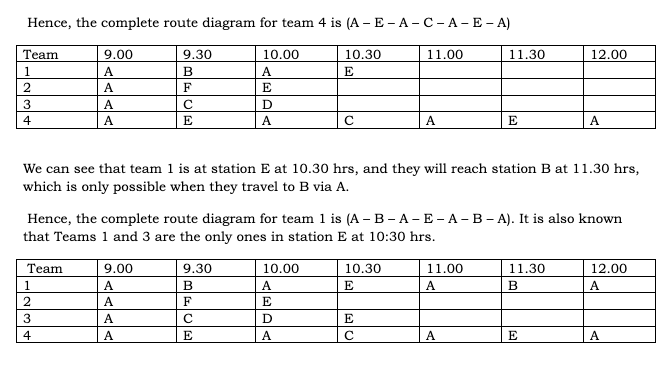 The only possible root for Team 2 at 10.00 hrs is from E to F since they can't choose E to D because Team 3 is already on this route. Since team 3 has to reach A at 12.00. The only possible combination for team 3 is E – D – C – A
The only possible root for Team 2 at 10.00 hrs is from E to F since they can't choose E to D because Team 3 is already on this route. Since team 3 has to reach A at 12.00. The only possible combination for team 3 is E – D – C – A
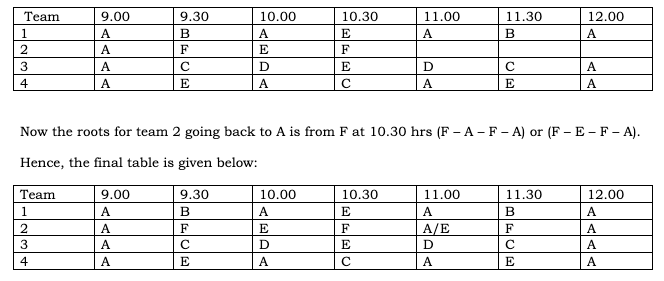 From the table, we can see that 2 teams (teams 3 and 4) have passed through station C on the given day.
The correct option is C
From the table, we can see that 2 teams (teams 3 and 4) have passed through station C on the given day.
The correct option is C
Correct Answer 11
Option D
Correct Answer 12
2
Correct Answer 13
Option A
Correct Answer 14
2
Correct Answer 15
Option C
CAT 2023 | DILR Set 4
DIRECTIONS for the question: Read the information given below and answer the question that follows.
- In every month, both online and offline registration numbers were multiples of 10.
- In January, the number of offline registrations was twice that of online registrations.
- In April, the number of online registrations was twice that of offline registrations.
- The number of online registrations in March was the same as the number of offline registrations in February.
- The number of online registrations was the largest in May.

16. What was the total number of registrations in April? (in numerical value)
Given that in every month, both online and offline registration numbers were multiples of 10. From (2), in Jan, the number of offline registrations was twice that of online registrations.
⟹ If x is number of online registrations ⟹ 2x is the number of offline registrations ⟹ 3x is the total number of registrations.
According to the data given in the table ⟹ 3x should lie between the minimum and maximum total number of registrations. ⟹ x = 40 (as x should also be a multiple of 10)
⟹ In Jan ⟹ (40, 80) are the online and offline registrations respectively.
Similarly from (3) ⟹ In Apr (80, 40) are the online and offline registrations respectively.
From – 5, the number of online registrations is highest in May ⟹ In may there are 100 online registrations. The lowest possible number of offline registrations is 30 and maximum possible total registrations is 130 ⟹ In May (100, 30) are the online and offline registrations respectively.
Let us assume, 'x' to be the number of offline registrations in May = number of online registrations in March.
Let us capture all this data in a table:
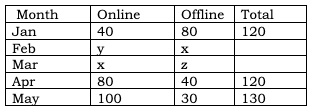 From the table given in the question, 50 is the median for Offline data
⟹ x should lie between 50 and 80 (included)
For 80 to be the median for the online data ⟹ y lie between 80 and 100 (included).
Now, consider Feb ⟹ Minimum value of y + x = 80 + 50 = 130 (which is the maximum value possible of the total possible registrations)
⟹ x = 50 and y = 80
Since, 110 is the minimum number of total registrations, the only possibility is in March ⟹ 50 + z = 110 ⟹ z = 60.
Now, filling the complete table we get,
From the table given in the question, 50 is the median for Offline data
⟹ x should lie between 50 and 80 (included)
For 80 to be the median for the online data ⟹ y lie between 80 and 100 (included).
Now, consider Feb ⟹ Minimum value of y + x = 80 + 50 = 130 (which is the maximum value possible of the total possible registrations)
⟹ x = 50 and y = 80
Since, 110 is the minimum number of total registrations, the only possibility is in March ⟹ 50 + z = 110 ⟹ z = 60.
Now, filling the complete table we get,
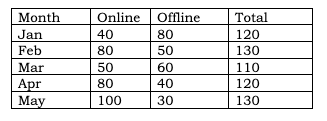 The total number of registrations in April is 120.
The total number of registrations in April is 120.
17. What was the number of online registrations in January? (in numerical value)
Given that in every month, both online and offline registration numbers were multiples of 10. From (2), in Jan, the number of offline registrations was twice that of online registrations.
⟹ If x is number of online registrations ⟹ 2x is the number of offline registrations ⟹ 3x is the total number of registrations.
According to the data given in the table ⟹ 3x should lie between the minimum and maximum total number of registrations. ⟹ x = 40 (as x should also be a multiple of 10)
⟹ In Jan ⟹ (40, 80) are the online and offline registrations respectively.
Similarly from (3) ⟹ In Apr (80, 40) are the online and offline registrations respectively.
From – 5, the number of online registrations is highest in May ⟹ In may there are 100 online registrations. The lowest possible number of offline registrations is 30 and maximum possible total registrations is 130 ⟹ In May (100, 30) are the online and offline registrations respectively.
Let us assume, 'x' to be the number of offline registrations in May = number of online registrations in March.
Let us capture all this data in a table:
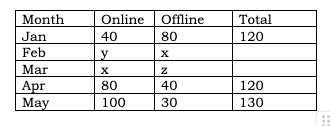 From the table given in the question, 50 is the median for Offline data
⟹ x should lie between 50 and 80 (included)
For 80 to be the median for the online data ⟹ y lie between 80 and 100 (included).
Now, consider Feb ⟹ Minimum value of y + x = 80 + 50 = 130 (which is the maximum value possible of the total possible registrations)
⟹ x = 50 and y = 80
Since, 110 is the minimum number of total registrations, the only possibility is in March ⟹ 50 + z = 110 ⟹ z = 60.
Now, filling the complete table we get,
From the table given in the question, 50 is the median for Offline data
⟹ x should lie between 50 and 80 (included)
For 80 to be the median for the online data ⟹ y lie between 80 and 100 (included).
Now, consider Feb ⟹ Minimum value of y + x = 80 + 50 = 130 (which is the maximum value possible of the total possible registrations)
⟹ x = 50 and y = 80
Since, 110 is the minimum number of total registrations, the only possibility is in March ⟹ 50 + z = 110 ⟹ z = 60.
Now, filling the complete table we get,
 The number of online registrations in Jan is 40.
The number of online registrations in Jan is 40.
18. Which of the following statements can be true?
I. The number of offline registrations was the smallest In May.
II. The total number of registrations was the smallest in February.
- Only I
- Neither I nor II
- Only II
- Both I and II
Given that in every month, both online and offline registration numbers were multiples of 10. From (2), in Jan, the number of offline registrations was twice that of online registrations.
⟹ If x is number of online registrations ⟹ 2x is the number of offline registrations ⟹ 3x is the total number of registrations.
According to the data given in the table ⟹ 3x should lie between the minimum and maximum total number of registrations. ⟹ x = 40 (as x should also be a multiple of 10)
⟹ In Jan ⟹ (40, 80) are the online and offline registrations respectively.
Similarly from (3) ⟹ In Apr (80, 40) are the online and offline registrations respectively.
From – 5, the number of online registrations is highest in May ⟹ In may there are 100 online registrations. The lowest possible number of offline registrations is 30 and maximum possible total registrations is 130 ⟹ In May (100, 30) are the online and offline registrations respectively.
Let us assume, 'x' to be the number of offline registrations in May = number of online registrations in March.
Let us capture all this data in a table:
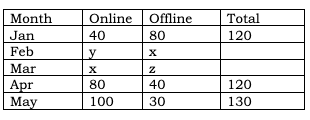 From the table given in the question, 50 is the median for Offline data
⟹ x should lie between 50 and 80 (included)
For 80 to be the median for the online data ⟹ y lie between 80 and 100 (included).
Now, consider Feb ⟹ Minimum value of y + x = 80 + 50 = 130 (which is the maximum value possible of the total possible registrations)
⟹ x = 50 and y = 80
Since, 110 is the minimum number of total registrations, the only possibility is in March ⟹ 50 + z = 110 ⟹ z = 60.
Now, filling the complete table we get,
From the table given in the question, 50 is the median for Offline data
⟹ x should lie between 50 and 80 (included)
For 80 to be the median for the online data ⟹ y lie between 80 and 100 (included).
Now, consider Feb ⟹ Minimum value of y + x = 80 + 50 = 130 (which is the maximum value possible of the total possible registrations)
⟹ x = 50 and y = 80
Since, 110 is the minimum number of total registrations, the only possibility is in March ⟹ 50 + z = 110 ⟹ z = 60.
Now, filling the complete table we get,
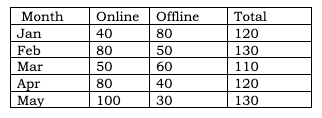 1) In May, there are 30 offline registrations (smallest) ⟹ True
2) In Mar, we have smallest number of total registrations ⟹ False.
1) In May, there are 30 offline registrations (smallest) ⟹ True
2) In Mar, we have smallest number of total registrations ⟹ False.
19. What best can be concluded about the number of offline registrations in February?
- 50 or 80
- 30 or 50 or 80
- 50
- 80
Given that in every month, both online and offline registration numbers were multiples of 10. From (2), in Jan, the number of offline registrations was twice that of online registrations.
⟹ If x is number of online registrations ⟹ 2x is the number of offline registrations ⟹ 3x is the total number of registrations.
According to the data given in the table ⟹ 3x should lie between the minimum and maximum total number of registrations. ⟹ x = 40 (as x should also be a multiple of 10)
⟹ In Jan ⟹ (40, 80) are the online and offline registrations respectively.
Similarly from (3) ⟹ In Apr (80, 40) are the online and offline registrations respectively.
From – 5, the number of online registrations is highest in May ⟹ In may there are 100 online registrations. The lowest possible number of offline registrations is 30 and maximum possible total registrations is 130 ⟹ In May (100, 30) are the online and offline registrations respectively.
Let us assume, 'x' to be the number of offline registrations in May = number of online registrations in March.
Let us capture all this data in a table:
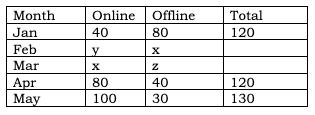 From the table given in the question, 50 is the median for Offline data
⟹ x should lie between 50 and 80 (included)
For 80 to be the median for the online data ⟹ y lie between 80 and 100 (included).
Now, consider Feb ⟹ Minimum value of y + x = 80 + 50 = 130 (which is the maximum value possible of the total possible registrations)
⟹ x = 50 and y = 80
Since, 110 is the minimum number of total registrations, the only possibility is in March ⟹ 50 + z = 110 ⟹ z = 60.
Now, filling the complete table we get,
From the table given in the question, 50 is the median for Offline data
⟹ x should lie between 50 and 80 (included)
For 80 to be the median for the online data ⟹ y lie between 80 and 100 (included).
Now, consider Feb ⟹ Minimum value of y + x = 80 + 50 = 130 (which is the maximum value possible of the total possible registrations)
⟹ x = 50 and y = 80
Since, 110 is the minimum number of total registrations, the only possibility is in March ⟹ 50 + z = 110 ⟹ z = 60.
Now, filling the complete table we get,
 The number of offline registrations in Feb is 50.
The number of offline registrations in Feb is 50.
20. Which pair of months definitely had the same total number of registrations?
I. January and April
II. February and May
- Neither I nor II
- Only II
- Both I and II
- Only I
Given that in every month, both online and offline registration numbers were multiples of 10. From (2), in Jan, the number of offline registrations was twice that of online registrations.
⟹ If x is number of online registrations ⟹ 2x is the number of offline registrations ⟹ 3x is the total number of registrations.
According to the data given in the table ⟹ 3x should lie between the minimum and maximum total number of registrations. ⟹ x = 40 (as x should also be a multiple of 10)
⟹ In Jan ⟹ (40, 80) are the online and offline registrations respectively.
Similarly from (3) ⟹ In Apr (80, 40) are the online and offline registrations respectively.
From – 5, the number of online registrations is highest in May ⟹ In may there are 100 online registrations. The lowest possible number of offline registrations is 30 and maximum possible total registrations is 130 ⟹ In May (100, 30) are the online and offline registrations respectively.
Let us assume, 'x' to be the number of offline registrations in May = number of online registrations in March.
Let us capture all this data in a table:
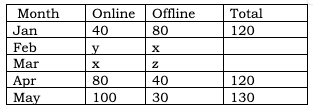 From the table given in the question, 50 is the median for Offline data
⟹ x should lie between 50 and 80 (included)
For 80 to be the median for the online data ⟹ y lie between 80 and 100 (included).
Now, consider Feb ⟹ Minimum value of y + x = 80 + 50 = 130 (which is the maximum value possible of the total possible registrations)
⟹ x = 50 and y = 80
Since, 110 is the minimum number of total registrations, the only possibility is in March ⟹ 50 + z = 110 ⟹ z = 60.
Now, filling the complete table we get,
From the table given in the question, 50 is the median for Offline data
⟹ x should lie between 50 and 80 (included)
For 80 to be the median for the online data ⟹ y lie between 80 and 100 (included).
Now, consider Feb ⟹ Minimum value of y + x = 80 + 50 = 130 (which is the maximum value possible of the total possible registrations)
⟹ x = 50 and y = 80
Since, 110 is the minimum number of total registrations, the only possibility is in March ⟹ 50 + z = 110 ⟹ z = 60.
Now, filling the complete table we get,
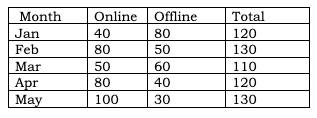 Total registrations in Jan = Apr = 120 and Feb = May = 130.
Total registrations in Jan = Apr = 120 and Feb = May = 130.
Correct Answer 16
120
Correct Answer 17
40
Correct Answer 18
Option A
Correct Answer 19
Option C
Correct Answer 20
Option C














